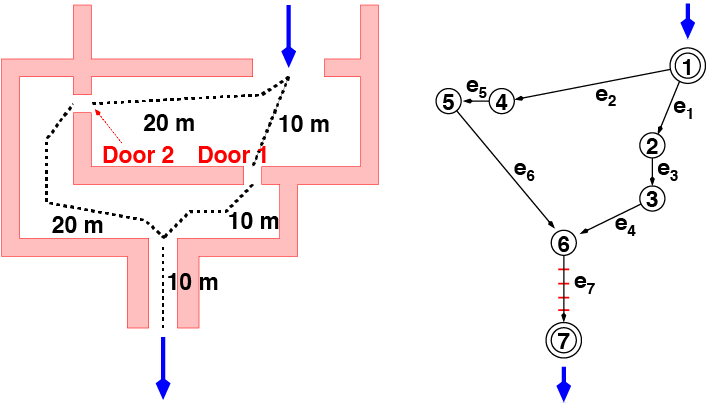Network Simulation for Pedestrian Flows with HyDEFS
DOI:
https://doi.org/10.17815/CD.2020.24Keywords:
pedestrians, event-driven simulation software, varying routing, macroscopicAbstract
The reliable simulation of pedestrian movement is an essential tool for the security aware design and analysis of buildings and infrastructure. We developed HyDEFS, an event-driven dynamic flow simulation software which is designed to simulate pedestrian movement depending on varying routing decisions of the individual users and varying constraints. HyDEFS uses given density depending velocities to model congestions and evaluates flow distributions with respect to average and maximum travel time. This is of particular importance when considering evacuation scenarios.
We apply HyDEFS on two small networks and cross validate its results by time-discrete and time-continuous calculations.
References
Predtechenskii, V.M., Milinskii, A.I.: Planning for Foot Traffic Flow in Buildings. Amerind Publishing, New Delhi (1978). Translation of: Proekttirovanie Zhdanii s Uchetom Organizatsii Dvizheniya Lyuddskikh Potokov, Stroiizdat Publishers, Moscow, 1969
DiNenno, P.J.: SFPE Handbook of Fire Protection Engineering, 3 edn. National Fire Protection Association, Quincy MA (2002)
Buchmueller, S., Weidmann, U.: Parameters of pedestrinas, pedestrian traffic and walking facilities. Tech. Rep. Schriftenreihe 132, ETH, Eidgenössische Technische Hochschule Zürich (2007)
Chraibi, M., Tordeux, A., Schadschneider, A., Seyfried, A.: Modelling of Pedestrian and Evacuation Dynamics, pp. 1-22. Springer, Berlin, Heidelberg (2018)
Dijkstra, E.W.: A note on two problems in connexion with graphs. Numer. Math. 1(1), 269-271 (1959). doi:10.1007/BF01386390
Kretz, T.: Pedestrian traffic: On the quickest path. Journal of Statistical Mechanics: Theory and Experiment P03012 (2009). doi:10.1088/1742-5468/2009/03/P03012
Kemloh Wagoum, A.U., Seyfried, A., Holl, S.: Modeling the dynamic route choice of pedestrians to assess the criticality of building evacuation. Advances in Complex Systems 15(3) (2012). doi:10.1142/S0219525912500294
Kneidl, A.: Methoden zur Abbildung menschlichen Navigationsverhaltens bei der Modellierung von Fußgängerströmen. Dissertation, Technische Universität München (2013)
Kielar, P.M., Biedermann, D.H., Kneidl, A., Borrmann, A.: A unified pedestrian routing model combining multiple graph-based navigation methods. In: Knoop, V.L., Daamen, W. (eds.) Traffic and Granular Flow '15, pp. 241-248. Springer International Publishing, Cham (2016). doi:10.1007/978-3-319-33482-0_31
Filippidis, L.: Representing the influence of signage on evacuation behavior within an evacuation model. Journal of Fire Protection Engineering 16(1), 37-73 (2006). doi:10.1177/1042391506054298
Nassar, K.: Sign visibility for pedestrians assessed with agent-based simulation. Transportation Research Record: Journal of the Transportation Research Board 2264, 18-26 (2011). doi:10.3141/2264-03
Kretz, T., Große, A., Hengst, S., Kautzsch, L., Pohlmann, A., Vortisch, P.: Quickest paths in simulations of pedestrians. Advances in Complex Systems 14(5), 733-759 (2011). doi:10.1142/S0219525911003281
Andresen, E., Chraibi, M., Seyfried, A.: A representation of partial spatial knowledge: a cognitive map approach for evacuation simulations. Transportmetrica A: Transport Science (2018). doi:10.1080/23249935.2018.1432717
Piccoli, B., Garavello, M.: Traffic Flow on Networks. American Institute of Mathematical Sciences, Springfield, MO (2006)
Garavello, M., Han, K., Piccoli, B.: Models for Vehicular Traffic on Networks. American Institute of Mathematical Sciences, Springfield, MO (2016)
Göttlich, S., Kühn, S., Ohst, J.P., Ruzika, S.: Evacuation dynamics influenced by spreading hazardous material. Networks and Heterogeneous Media 6, 443 (2011). doi:10.3934/nhm.2011.6.443
Göttlich, S., Kühn, S., Ohst, J.P., Ruzika, S.: Evacuation modeling: a case study on linear and nonlinear network flow models. EURO Journal on Computational Optimization 4(3), 219-239 (2016)
Nishinari, K., Kirchner, A., Namazi, A., Schadschneider, A.: Extended floor field CA model for evacuation dynamics. IEICE Trans. Inf. Syst. E87-D(3), 726-732 (2004)
Kimms, A., Maassen, K.C.: A fast heuristic approach for large-scale cell-transmission-based evacuation route planning. Networks 60(3), 179-193 (2012). doi:10.1002/net.21457
Rausch, M., Treiber, M., Lämmer, S.: A microscopic decision model for route choice and event-driven revisions. arXiv e-print 1805.05076 (2018). URL https://arxiv.org/abs/1811.11295
Scellato, S., Fortuna, L., Frasca, M., Gómez-Garde nes, J., Latora, V.: Traffic optimization in transport networks based on local routing. Eur. Phys. J. B 73(2), 303-308 (2010). doi:10.1140/epjb/e2009-00438-2
Sun, H.J., Wu, J.J., Gao, Z.Y.: Dynamics of routing mechanisms on traffic networks. Int. J. Mod. Phys. C 18(11), 1775-1782 (2007). doi:10.1142/S012918310701173X
Danila, B., Sun, Y., Bassler, K.E.: Collectively optimal routing for congested traffic limited by link capacity. Phys. Rev. E 80(6), 066116 (2009). doi:10.1103/PhysRevE.80.066116
Ezaki, T., Yanagisawa, D., Nishinari, K.: Pedestrian flow through multiple bottlenecks. Phys. Rev. E 86, 026118 (2012). doi:10.1103/PhysRevE.86.026118
Bittihn, S., Schadschneider, A.: Braess paradox in a network of totally asymmetric exclusion processes. Phys. Rev. E 94, 062312 (2016). doi:10.1103/PhysRevE.94.062312
Bittihn, S., Schadschneider, A.: Braess paradox in a network with stochastic dynamics and fixed strategies. Physica A: Statistical Mechanics and its Applications 507, 133 - 152 (2018). doi:10.1016/j.physa.2018.05.018
Selten, R., Chmura, T., Pitz, T., Kube, S., Schreckenberg, M.: Commuters route choice behaviour. Games and Economic Behavior 58(2), 394-406 (2007). doi:10.1016/j.geb.2006.03.012
Rapoport, A., Kugler, T., Dugar, S., Gisches, E.: Choice of routes in congested traffic networks: Experimental tests of the Braess paradox. Games and Economic Behavior 65(2), 538-571 (2009). doi:10.1016/j.geb.2008.02.007
Braess, D.: Über ein Paradoxon aus der Verkehrsplanung. Unternehmensforschung 12, 258-268 (1968)
Braess, D., Nagurney, A., Wakolbinger, T.: On a paradox of traffic planning. Transportation Science 39, 446-450 (2005)
Baumann, N., Skutella, M.: Earliest arrival flows with multiple sources. Mathematics of Operations Research 34(2), 499-512 (2009). URL http://www.jstor.org/stable/40538395

Downloads
Published
How to Cite
Issue
Section
License
Copyright (c) 2020 Kathrin Klamroth, Bruno Lang, Armin Seyfried, Michael Stiglmayr

This work is licensed under a Creative Commons Attribution 4.0 International License.
Authors contributing to Collective Dynamics agree to publish their articles under the Creative Commons Attribution 4.0 license.
This license allows:
Share — copy and redistribute the material in any medium or format
Adapt — remix, transform, and build upon the material
for any purpose, even commercially.
The licensor cannot revoke these freedoms as long as you follow the license terms.
Authors retain copyright of their work. They are permitted and encouraged to post items submitted to Collective Dynamics on personal or institutional websites and repositories, prior to and after publication (while providing the bibliographic details of that publication).








